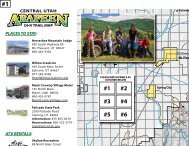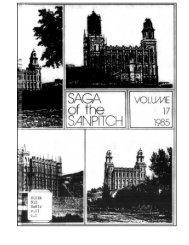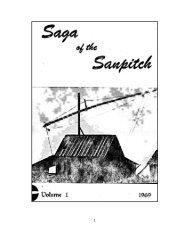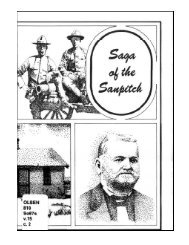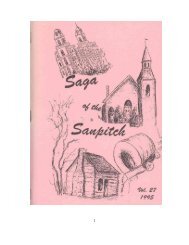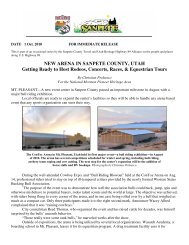Saga of the Sanpitch Volume 13, 1981 - Sanpete County
Saga of the Sanpitch Volume 13, 1981 - Sanpete County
Saga of the Sanpitch Volume 13, 1981 - Sanpete County
- TAGS
- saga
- sanpitch
- volume
- sanpete
- sanpete.com
Create successful ePaper yourself
Turn your PDF publications into a flip-book with our unique Google optimized e-Paper software.
circled <strong>the</strong> fort within <strong>the</strong> walls and ano<strong>the</strong>r ran from one gate to ano<strong>the</strong>r and also across <strong>the</strong> center <strong>of</strong> <strong>the</strong><br />
fort from north to south.<br />
Because <strong>of</strong> Indian troubles, <strong>the</strong> fort was abandoned for six years, and when <strong>the</strong> residents returned in<br />
1866, <strong>the</strong> fort required some additional work. At that time, <strong>the</strong> south wall, which had once been made up <strong>of</strong><br />
houses, was replaced with a strong rock wall. The wall facing <strong>the</strong> west was made higher and two bastions were<br />
built at <strong>the</strong> sou<strong>the</strong>ast and northwest corners. Portholes in <strong>the</strong>se structures allowed all activities along any wall<br />
<strong>of</strong> <strong>the</strong> fort to be observed so that <strong>the</strong> alarm could be given if danger threatened.<br />
In a short time settlers began to build outside <strong>the</strong> walls, but all stayed close for safety; and when <strong>the</strong><br />
bass drum sounded, <strong>the</strong>y took shelter within <strong>the</strong> safety <strong>of</strong> <strong>the</strong> fort.<br />
With time and <strong>the</strong> march <strong>of</strong> progress, <strong>the</strong> old fort fell to make way for more modern structures. The<br />
buildings fell into disuse and decay or were torn down as <strong>the</strong> town took on a look much like that <strong>of</strong> o<strong>the</strong>r small<br />
towns throughout <strong>the</strong> country.<br />
The fort lives on today only in <strong>the</strong> writings <strong>of</strong> early settlers or <strong>the</strong>ir descendants who have preserved<br />
stories <strong>of</strong> <strong>the</strong>ir ancestors' lives. To history buffs, <strong>the</strong> fort is <strong>of</strong> interest as a part <strong>of</strong> early Utah, but <strong>the</strong> average<br />
traveler down <strong>the</strong> city's main street is unaware that <strong>the</strong> block which now houses a car lot, homes, and cafe,<br />
was where <strong>the</strong> east wall <strong>of</strong> <strong>the</strong> fort <strong>of</strong> Fairview once stood.<br />
That fort, and <strong>the</strong> forts <strong>of</strong> all <strong>the</strong> o<strong>the</strong>r towns in <strong>the</strong> valley, was an integral part <strong>of</strong> <strong>the</strong> life <strong>of</strong> early<br />
<strong>Sanpete</strong>. It and <strong>the</strong> o<strong>the</strong>rs served <strong>the</strong>ir purpose well in protecting <strong>the</strong> early settlers from Indian raids and<br />
allowing <strong>the</strong> settlements <strong>of</strong> <strong>the</strong> valley to take root and grow into what <strong>the</strong>y have become today.<br />
Sources: Unpublished Day and Coombs History <strong>of</strong> Fairview<br />
Material in Fairview Museum<br />
Conversations with Sylvia Miner and Golden Sanderson<br />
FARMER'S SON, THE AGONY AND THE ECSTASY<br />
Halbert S. Greaves<br />
1904 Herbert Avenue<br />
Salt Lake City, Utah 84108<br />
Pr<strong>of</strong>essional Division, First Place Personal Recollection<br />
My fa<strong>the</strong>r was an enterprising man. During his life <strong>of</strong> more than sixty years he tackled a wide range <strong>of</strong><br />
vocations to support a large family. Farming was one.<br />
Most farm equipment used in 1923, when I was fifteen, is obsolete now. I shall discuss two: <strong>the</strong><br />
Jackson-fork 1 and <strong>the</strong> self dump rake. I shall add some memories <strong>of</strong> <strong>the</strong> coal-delivery wagon. My fa<strong>the</strong>r was<br />
also a coal dealer.<br />
The Jackson-fork was associated with one <strong>of</strong> my most detested jobs, alfalfa stacker in a barn almost<br />
entirely closed in. Getting <strong>the</strong> alfalfa into <strong>the</strong> barn was a three-man, one-horse chore (sometimes two horses).<br />
The man-jobs were assigned by age; <strong>the</strong> oldest <strong>of</strong> <strong>the</strong> three bro<strong>the</strong>rs still living at home operated <strong>the</strong><br />
Jackson-fork. The fork, with its four long, curved tines, had to be manipulated by hand to an exact spot on <strong>the</strong><br />
load <strong>of</strong> alfalfa where it would be forced down into <strong>the</strong> hay to get <strong>the</strong> maximum load and to keep <strong>the</strong> load-level<br />
even. The second-oldest bro<strong>the</strong>r drove <strong>the</strong> horse that pulled <strong>the</strong> cable attached to <strong>the</strong> fork so it would ascend<br />
by a system <strong>of</strong> pulleys to <strong>the</strong> track along which it would be pulled into <strong>the</strong> barn and dumped where it was to<br />
be stacked.<br />
As <strong>the</strong> youngest son, my job was to keep <strong>the</strong> hay evenly spread out. The barn became hotter and<br />
hotter as <strong>the</strong> stack rose higher, and <strong>the</strong> alfalfa dust became more dense in <strong>the</strong> narrower spaces under <strong>the</strong><br />
19



